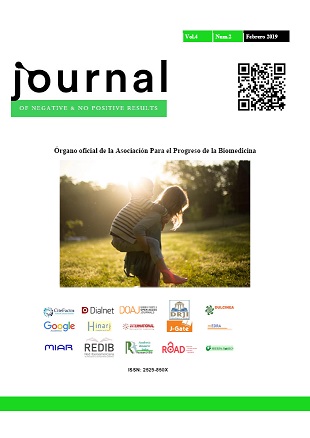The ingestion of aflatoxigenic foods and their possible implications with cervical cancer
DOI:
https://doi.org/10.19230/jonnpr.2821Keywords:
Aflatoxigenic foods, aflatoxins, ingestion, association, cervico-uterine cancerAbstract
Cancer has been one of the most deadly diseases in the world; In the female population Cervical Cancer [CaCu], is one of the most frequent and deadly, which could be caused by different infectious, food, socioeconomic and cultural factors, to mention a few. Consuming aflatoxigenic foods such as [corn tortilla, almonds, rice, oats, peanuts, pistachios, among others] contaminated with Aspergillus parasiticus, A. nonius and A. flavus could pose a risk for CaCu.
Objective. Determine the pattern of ingestion of aflatoxigenic foods in women diagnosed with [CaCu].
Material and methods. The study was observational cross-sectional. For this investigation, a study was carried out on 120 women; Persons who were previously selected according to a database provided by a health institution. Results. The results of the surveys show the high consumption of foods containing aflatoxins in patients diagnosed with Cervical-uterine Cancer.
Conclusions. Women report high intakes of aflatoxigenic foods that may be involved in the development of [CaCu] and most likely with other epidemiological events. Failure to pay attention to patterns of food and poverty allows anticipating non-positive results in human health.
Downloads
References
Harlem BG. El Informe de Cáncer Mundial. Los hallazgos mayores emitidos en la Organización de Salud Mundial (WHO). 2003;pp:351.
Modificación a la Norma Oficial Mexicana (NOM-014-SSA2-1994) para la prevención, detección, diagnóstico, tratamiento, control y vigilancia epidemiológica del cáncer cervicouterino. Diario Oficial, 2007.
Hidalgo-Martínez A. El cáncer cervicouterino, su impacto en México y el porqué no funciona el programa nacional de detección oportuna. Rev Biomed 2006; 17: 81-4.
Martínez F. Epidemiología del cáncer del cuello uterino. Medicina Universitaria 2004; 6(22): 39-46.
Nobuko NI, Shigueaki HG, Kowalski LP, Gama RJ, Iriya K, Sasazuki S, et al. Risk factors for stomach cancer in Brazil (1): a case- control study among non-Japanese Brazilians in Sao Paulo. Jpn J Clin Oncol 2002;32:227-83.
Ames B, et al. Dietary carcinogens and anticarcinogens. Science 1984;224:659.
Dadatti MS, Polleto L, Pezzotto SM. Evolución de las tasas de mortalidad por cáncer de mama en Rosario, Argentina. Asociación con factores socioeconómicos. Ginecol Obstet Mex 2002;70:275-80
Mislyvec, P.B., J.H.Hunter and J.Tuite. 1966. Assay for afiatoxin production by the genera Aspergillm and Penicillium. Appl. Microbiol. 16: 1053-1055.
Davis, N.D., U.L.Diener y D. W. Eldrige. 1966. Production of atlatoxins B1 and G1 by Asperg'llusflavm in somisynthetic medium. Appl. Microbiol. 14: 378-380.
Wilson, B. J., T. Colin., k Wdace and R.T.Hanlin. 1968. Investigation of reported afiat~xinp roduction by fungi outside the Aspergillirs flavus group. Ap~lM. icrobiol. 16:819-821.
Valladares L. Introducción al tema de micotoxinas y micotoxicosis. Bol Micolog 1988; 4:1-26
Ocurrence of aflatoxin in peanut and corn products moving in international trade. In: Sampling plans for aflatoxins in peanuts and corn. FAO #55. Rome, Italy, 1993: 1-63
Soriano-del-Castillo JM, et al. Micotoxinas en alimentos. 1a ed. Madrid: Ediciones Díaz de Santos; 2007.
Ellis W, Smith J, Simpson B. Aflatoxins in food: ocurrence, byosynthesis, effects on organisms, detection, and methods of control. Critical reviews in food science nutrition 1991; 30:403-39
Chelskowski J. Cereal grain mycotoxins, fungi and quality in drying and storage. Elsevier, Amsterdam 1991: 53-77.
Bennett JW, Klich M. Mycotoxins. Clinical Microbiology Reviews. 2003;16(3):497-516.
Bergamini E, Catellani D, Dall’asta C, Galaverna G, Dossena A, Marchelli R, et al. Fate of Fusarium mycotoxins in the cereal product supply chain: the deoxynivalenol (DON) case within industrial bread- making technology. Food Additives & Contaminants: Part A. 2010;27(5):677-87.
Ruvalacaba Ledezma J.C. Alimentación aflatoxigénica y sus implicaciones en la salud humana, análisis de la exposición dependiente de la vulnerabilidad socioeconómica. Egresados en Contacto, Voces, Egresados.udg.mx, Agosto, 2008.
Ruvalcaba Ledezma Jesús Carlos, Interían Gómez Leticia, Flores Salinas Eduardo Efrain and Raygoza Anaya Miguel. Aflatoxigenic feeding and its possible implications after pregnancy Biomedical & Pharmacology Journal, ISSN: 0974 6242, 2014; 7(1): 183-193
Abaroa-Aguirre MF, Sánchez-Godoy EG, Escamilla-Violante R, and Ruvalcaba Ledezma JC. Intake time safercorn tortilla by Aspergillus sp. growth in culture. Int. J. Pure App. Biosci. 2015; 3 (3): 22-27
Published
Issue
Section
License
All accepted originals remain the property of JONNPR. In the event of publication, the authors exclusively transfer their rights of reproduction, distribution, translation and public communication (by any sound, audiovisual or electronic medium or format) of their work. To do so, the authors shall sign a letter transferring these rights when sending the paper via the online manuscript management system.
The articles published in the journal are freely used under the terms of the Creative Commons BY NC SA license, therefore.
You are free to:
Share — copy and redistribute the material in any medium or format
Adapt — remix, transform, and build upon the material
The licensor cannot revoke these freedoms as long as you follow the license terms.
Under the following terms:
Attribution — You must give appropriate credit, provide a link to the license, and indicate if changes were made. You may do so in any reasonable manner, but not in any way that suggests the licensor endorses you or your use.
NonCommercial — You may not use the material for commercial purposes.
ShareAlike — If you remix, transform, or build upon the material, you must distribute your contributions under the same license as the original.
No additional restrictions — You may not apply legal terms or technological measures that legally restrict others from doing anything the license permits.

This work is licensed under a Creative Commons Attribution-NonCommercial-ShareAlike 4.0 International License

























